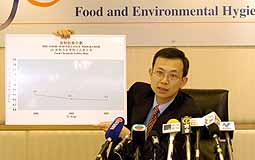 |
| Safe to eat: Food & Environmental Hygiene Department Assistant Director Dr Thomas Chung says Hong Kong's food safety standards remain high. |

|
The Food & Environmental Hygiene Department's analysis of food samples it collected last year show that food safety standards remain high.
Announcing the department's 2003 food surveillance results today, Assistant Director Dr Thomas Chung said the failure rates for both microbiological and chemical testing remained at a low level, compared with findings in 2001 and 2002.
The overall failure rate for about 53,000 tests conducted last year was 0.3%, compared with 0.5% in 2001 and 0.3% in 2002.
While microbiological tests target pathogenic bacteria and viruses, chemical tests detect natural toxins, food additives and contaminants, he explained.
13 samples with pathogens
For microbiological tests, Dr Chung said about 17,000 food samples were analysed last year, with pathogens found in 13 samples.
"This represented a failure rate of 0.1%, compared with 0.3% in 2001 and 0.1% in 2002."
The pathogens detected included bacteria such as Staphylococcus aureus and Clostridium perfringens. This reflected the importance of good hygiene practice in food handling and the need for proper storage during cooling, transport, and sale before it is eaten.
Of the 34,000 food samples tested for chemicals last year, 128 were found unsatisfactory, a failure rate of 0.4%, he said.
"It is encouraging to see that the rate remains low, compared with 0.6% in 2001 and 0.4% in 2002."
Chemical contamination problems ease
The failure rate for pesticide abuses testing had been improving, Dr Chung said. There was no report of food poisoning due to consumption of contaminated vegetables last year.
He also pointed out that compliance with the use of food colouring had improved considerably over the past three years. The only case of contravention related to mislabelling for a permitted colouring substance.
"However, we would like to remind the food trade of the judicious use of preservatives. Preservatives in fresh food such as fresh meat are not allowed.
"For other food, only permitted preservatives should be used. The amount added should follow good manufacturing practice and comply with the legal requirements."
Food safety rules should be followed
Householders and food handlers are advised to follow the food safety rules advocated by the World Health Organisation. They are:
* keep food clean;
* separate raw and cooked food;
* cook food thoroughly;
* keep food at safe temperatures (preferably at four
degrees Celsius or below, or above 60 degrees Celsius); and * use safe water and fresh foods.
Go To Top
|



